The devotion to Our Lady of Glastonbury originated in the historical mists that swirl do tantalisingly around that holy and venerable, remarkable and sometimes eccentric town in Somerset.
Legends - of varying antiquity and authenticity - tell of a visit by the teenage or young Jesus in the company of his uncle Joseph of Arimathes, who was on a tin-buying business visit, and that Our Lord employed and skill as a carpenter in building what became known as the Old Church of Glastonbury - ‘not made by human hands’ - and dedicated it to his Mother .... I suspect much of this story owes its origin or diffusion to post-reformation English exceptionalism rather than anything else.
That doubt having been raised I will add that the very distinguished Arthurian and Glastonbury scholar Geoffrey Ashe has suggested that the Tor might have been an ancient, very ancient, place of pagan pilgrimage, and that its ‘terraces’ are not so much cultivation lynchets as part of a processional way
Be that as it may the stronger medieval tradition is, of course, that of Joseph of Arimathea coming to Glastonbury with two vials or cruets containing blood from the Crucifixion and of his staff taking root in Wearyall Hill, bursting into leaf and eventually blooming as the Holy Thorn at Christmastide. This it’s descendants have continued to do, as I have seen myself. The species of the Holy Thirn has been shown to be of a type that originated in the Middle East.
By about 700 when it received grants from King Ine of Wessex there was a monastery at Glastonbury in a complex with a long established place of Christian burial to the south of the Old Church - the place where the bones of King Arthur and Queen Guinevere were identified in the late twelfth century, but the tradition of their buria there may be at least two centuries older. In the earliest accounts of him King Arthur he is described as bearing an image of the Virgin on his back in battle and later illustrators sometimes assigned him this as a coat of arms.

Miniature of King Arthur, holding a spear and a shield emblazoned with the Virgin and Child from a historical collection including Langtoft’s chronicles: Northern England, c. 1307 - c. 1327, Royal MS 20 a ii, f. 4r
Image:British Library
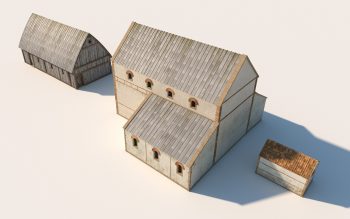
Digital reconstruction of an early phase of the church, around 700. The Old Church is on the left.
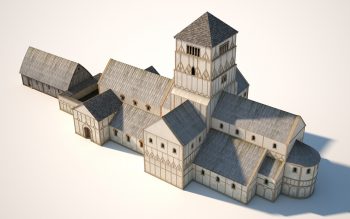
Digital reconstruction of the last phase of the Anglo-Saxon church, around 1000 AD
Images: arch.reading.ac.uk
‘The church at Glastonbury… is the oldest of all those that I know of in England… In it are preserved the bodily remains of many saints, and there is no part of the church that is without the ashes of the blessed. The stone-paved floor, the sides of the altar, the very altar itself, above and within, are filled with relics close-packed. Deservedly indeed is the repository of so many saints said to be a heavenly shrine on earth.’
— William of Malmesbury in the mid-twelfth century
The abbey was refunded about 940 by St Dunstan as a Benedictine house and therein began the tenth century English monastic revival.
Following the Norman conquest the abbey was rebuilt and expanded, but always preserved the old wooden church, to which lead sheeting was attached to protect it. However on May 24th 1184 fire devastated the abbey and the Old Church was lost.
It was the first part to be rebuilt, the new building being completed in two years. King Henry II paid for it and work on finishing the project stopped with his death and payments - hence it is suggested the failure to complete the carving around the south door. Interestingly it is built in an elaborate Romanesque style, then going out of fashion, and very different from the new abbey church to its east. This may be more than just a change of commission or master mason but a conscious attempt to make the Lady Chspel look older and distinct.
At a later stage in the development of the abbey church a Galilee porch was built to link the Lady Chapel to the main monastic church. As a result, like Durham Cathedral, the chapel dedicated to the Virgin is at the west rather than the east end.
The Lady Chapel at Glastonbury
Image:arch.reading.ac.uk
The following is taken from the website about their recent work at the abbey by the archaeological team from Reading:
A later addition to the 1140s chronicle of William of Malmesbury described a miraculous wooden painted statue of the Virgin and Child which survived the fire that destroyed the ‘Old Church’ in 1184.
The face of the Virgin’s sculpture was blistered by the heat as if it was a living person, but the rest of the statue was apparently unscathed. It was believed that the statue could perform miracles and it was given a place of honour in the eastern end of the newly-built Lady Chapel. The fame of the miraculously-preserved statue spread and many pilgrims came to the Lady Chapel seeking cures and blessings from the Virgin Mary.
The Lady Chapel from the south west.
The site of the original grave of King Arthur is to the right
Image: britainexpress.com
There is brief film of a digital reconstruction, also from the Reading online site, which aims to give an idea of the interior of the Lady Chapel based on surviving fragments and other buildings. It gives a good impression as to an overall scheme and the way the colour and decoration would have been applied although I am not convinced about the screen depicted:
/digital/the-lady-chapel-c-1185-1539/building-of-the-lady-chapel/
The second common seal of the abbey from the thirteenth century shows the enthroned Virgin and Child between two vending angels. The Virgin holds a fleur de lys in her right hand. The best extant example of that seal is in the archives of Magdalen College in Oxford and they have a piece about it at Buried Treasure: The Second Common Seal of Glastonbury Abbey
The fourteenth century third seal has on one side the Blessed Virgin flanked by SS Catherine and Margaret and on the other side St Dunstan between St Patrick and St Benignus. In this presentation Our Lady no longer holds a
fleur de lys but rather a tree eradicated - that is with its roots displayed - and the tree bearing flowers. Though assumed by some to be roses - so often associated with the Virgin - but at Glastonbury surely it is the Holy Thorn that is signified: a dry stick planted in the holy ground of Glastonbury received new life and blossoms. It is this seal image which was copied for the twentieth century statue. There is a drawing of the seal at
Image: Glastonbury Abbey

The modern statue of Our Lady of Glastonbury
Image: paulwestonglastonury.com
At the beginning of the sixteenth century Marian devotion at Glastonbury was augmented by the penultimate Abbot, Richard Bere (1493-1525), who, following a visit to Italy, built the Loretto Chapel. What is apparently a strange position, abutting the west wall of the north transept is, of course, when one understands the lack of a proper east wall in the Holy House at Loretto, the right arrangement.
Reconstruction model of Glastonbury Abbey on the eve of the suppression.
The Lady Chapel is on the right, the Loretto Chapel to the right of the North Transept.
Image: simanaitissays.com
In
1939-40 a new Catholic Church was built in the town, facing the site of the abbey and in July 1955 a statue of Our Lady of Glastonbury was carved and installed in the sanctuary. It was crowned by the Apostolic Delegate in 1965. A tapestry was installed that year depicting the Saints and Martyrs of Glastonbury. There is more about the church at Glastonbury - Our Lady St Mary of Glastonbury
The statue and tapestry together with the Tabernacle in the parish church
Image: taking-stock.org.uk
Dom Bede, the parish priest from the re-established Benedictine community in Glastonbury, and a friend of mine from Oriel, was making available copies of the statue as a means of encouraging devotion. He wrote about this on his blog in 2018 in a post which can be seen at
Statues for Sale
Our Lady of Glastonbury Pray for us
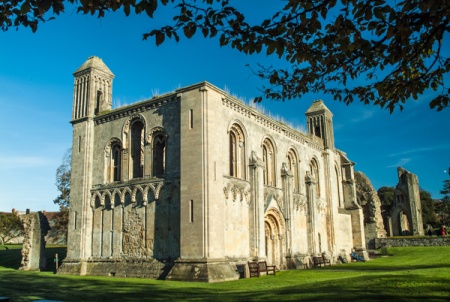




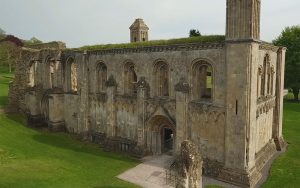


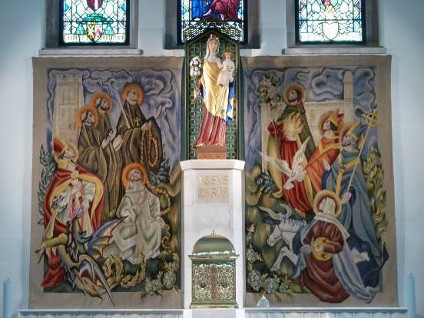
No comments:
Post a Comment